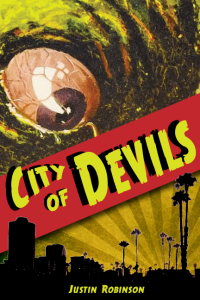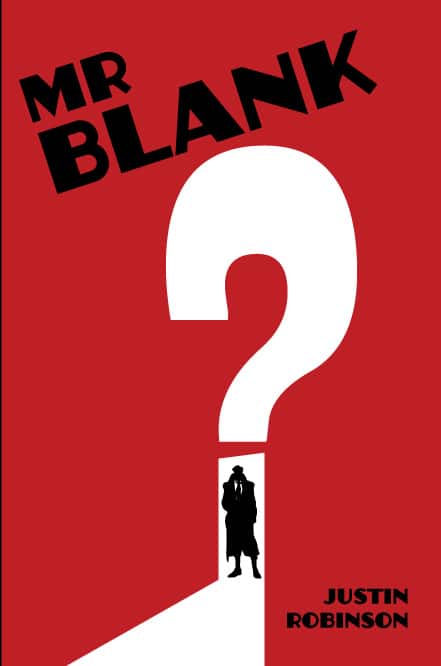 I do a lot of conventions, and I learned one thing very quickly. When someone stops by my booth, points at the rack of books, and asks what they’re about, it pays to have what’s called an elevator pitch to spew at them. It’s called that because if you happen to find yourself in an elevator with Harvey Weinstein, or Frank Darabont, or Nicolas Cage, you have the length of an elevator ride to convince them to make your movie. (With Cage, you can just shout “TAX HAVEN!” so maybe he was a bad example.) It’s always one or two sentences that distills your deliriously complex work of unparalleled art into a simple idea that even a film executive can understand. Some spring fully formed to the lips the instant you pitch them. Others are like pulling teeth from an amorous rhino. I think I’m finally homing in on my City of Devils elevator pitch. See what you think, and tell me if I can do better: “It’s about the last human detective in a world of monsters.” I pause. “It’s a comedy.”
I do a lot of conventions, and I learned one thing very quickly. When someone stops by my booth, points at the rack of books, and asks what they’re about, it pays to have what’s called an elevator pitch to spew at them. It’s called that because if you happen to find yourself in an elevator with Harvey Weinstein, or Frank Darabont, or Nicolas Cage, you have the length of an elevator ride to convince them to make your movie. (With Cage, you can just shout “TAX HAVEN!” so maybe he was a bad example.) It’s always one or two sentences that distills your deliriously complex work of unparalleled art into a simple idea that even a film executive can understand. Some spring fully formed to the lips the instant you pitch them. Others are like pulling teeth from an amorous rhino. I think I’m finally homing in on my City of Devils elevator pitch. See what you think, and tell me if I can do better: “It’s about the last human detective in a world of monsters.” I pause. “It’s a comedy.”
Yeah, it could probably use some work, but the preview copies did well at Scare L.A. I’ll probably hit on the perfect one right after convention season ends, because that’s how the human mind works.
I’m not quite certain where the idea for the actual book initially came from. City of Devils is the seventh novel I’ve written, nestled right between Everyman and Coldheart. At the time, I was coming off writing horror, and for those who maybe haven’t checked out my horror, it can get a little dark. I was in the mood to write some comedy, which I hadn’t done since my first Candlemark & Gleam publication, Mr Blank. Of everything I wrote, that was the one that flowed most freely, and I was hoping to capture that airy feeling I had when writing it. That it would be a comedy was a given, and ditto for noir, putting me right smack in the middle of my comfort zone. I started thinking about alternate worlds I liked, and many of them came down to the same principle: the last human being in a world full of [blank].

I love monsters and have since I was very little, probably a gift from my father, who never met a horror move he didn’t like. He was a devoted fan of the classics, and bought me a set of the Universal Monsters action figures which are sadly lost now, victims of my childhood. When they invent time travel, I’m going back to get them. Maybe that’s why they were lost? GODDAMN IT, FUTURE ME. Anyway, other than the action figures, all of which were in steady rotation (it was not unusual to see the Creature from the Black Lagoon cruising around in Luke Skywalker’s landspeeder), I remember quite clearly a Universal Monsters coloring book. My favorite page was The Fly, so much so that in the fifth grade (or thereabouts), I dressed up in a homemade Fly costume for Halloween. We started with one of the cheap Jason hockey masks, cut a couple tennis balls in half for the eyes, added some pipe-cleaner feelers, and spraypainted the whole thing. Along with a three-fingered glove, a hood for my head, and a lab coat, I had my favorite costume of my youth. That’s partly why the very first monster you see in the finished novel is the Fly (why he’s named after a Cramps song has more to do with my love of rockabilly, which didn’t start in earnest until much later).
Taking these two ideas, I had the last human being in a world full of monsters. That was an idea with legs (lots and lots of evil spider legs), but I had to work out the metaphysics of the whole thing. Did the monsters show up like immigrants? Were they invaders? What the hell, man? Because many of the classic monsters start as human — vampires, werewolves, mummies, and so on — I took this as the baseline. Monsters turn humans into themselves. That’s how they reproduce. After that eureka moment, the world really fell into place, from the station of humanity, to the Fair Game Law, and finally the (hopefully not obnoxious) metaphors of the whole thing.
With the world in place, I turned to the plot. I made the decision that I wanted to get back into noir. I hadn’t written any since Undead On Arrival, and when I started trying to hammer out the plot, I found, with a mounting sense of horror, that I was out of practice. The connections between plans and thugs and dames that used to be almost instinctual had faded. I realized I would be best served connecting the Evil Plot with the central metaphysics of the world. Doing so would save me time and reader interest, as I wouldn’t need to double up on the exposition. By explaining the one idea, I would prime the reader for the second, and then that first part wouldn’t seem like such a waste of time. Hopefully.
The main monster characters came from a desire to showcase some of my favorites from the classics. I decided early on that there would be no major vampires, simply because of overexposure. The rest were selected mostly for personal preference. I just happen to like phantoms, gremlins, and crawling eyes. From there, I sketched out the prevailing social order and tried to think of logical occupations for each kind of monster. Phantoms had to be musicians. Gremlins were inventors and machinists. Werewolves were cops. It all had to make sense in the internal logic of the world.
“Oculon” was the first name that popped into my head, and one of the primary catalysts for actually sitting down and writing. Rebirth names became an integral part of the universe, and truth be told, one of my favorite parts, since I got to indulge. As an author, I value a sense of audacity. I like it when someone has the stones to do something big and weird. I felt like giving characters names like Oculon, Ugoth the Castrator, or Hexene Candlemas was the kind of thing that took confidence, something of which I’m often in short supply. Some of the names were flashes of inspiration, springing fully-formed onto the page: Serendipity Sargasso, Lou Garou and Phil Moon, and Cacophony Jones and the Disasters. Others went through a few drafts before I got what I want: Aria Enchantee, Imogen Verity, and Lobo Castle.
I was, of course, haunted by the notion that Kate Sullivan, the big boss of Candlemark & Gleam, would hate the book. There’s no greater fear than the possibility of not getting what we really, really want, and this is the phenomenon that describes the life of an author. Well, Kate loved it, but her notes pinpointed a problem that I knew, in the back of my head, was going to be there. The timeline: she had no idea when the damn thing was to take place.
I intended it to be in June of 1955 (though I never come right out and say it in the book, mostly because I’m a cryptic bastard), but it’s not our 1955. History diverged 10 years earlier, when the monsters started appearing, so Los Angeles isn’t going to look exactly like it did then. I used pictures of the city in the late ‘40s as a guideline, and in my mind added scars from the Night War and additions for monsters. Culture would likely still advance, which is why there’s a rock and roll band running around. Well, that and that I love the 1984 cinematic oddity Streets of Fire, and desperately wanted an equivalent of the Bombers in my city. And yes, Cacophony Jones is totally supposed to be Phil Alvin from the Blasters. Except that Phil is, by all accounts, a really nice guy and not a criminal biker. Imogen’s house is also very real, and a couple of blocks from where I grew up in the Echo Park area of Los Angeles. You can probably find it on Google Earth without too much trouble. Look for the swan hitching post. The whole neighborhood is a historical zone for all the turn-of-the-century Victorian houses.
The reaction to the book has thus far been almost entirely positive, so I should probably get back to work on the sequel here. Escuerzo is, after all, still missing.

